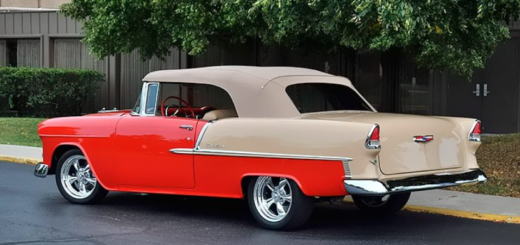LOUD Pontiac GTO Custom Pro-Touring Build | DIY Project Car

Mike built this badass Pontiac GTO in his garage after his father bought it brand new and passed it down to him. This car just looks so classy and yet it has all the modern upgrades you need to make this thing a great driver, so sit back and enjoy the ride…
The 1969 model eliminated the front door vent windows, had a slight grille and taillight revision, moved the ignition key from the dashboard to the steering column (which locked the steering wheel when the key was removed, a federal requirement installed one year ahead of schedule), and the gauge face was changed from steel blue to black. In addition, the rear quarter-panel mounted side marker lamps changed from a red lens shaped like the Pontiac “arrowhead” emblem to one shaped like the broad GTO badge. Front outboard headrests were made standard equipment on all cars built for 1969.

Via – fastmontysgarage
The previous economy engine and standard 350 hp 400 cu in (6.6 L) V8 engine remained, while the 360 hp (270 kW) “400 H.O.” was upgraded to the “400 Ram Air” (though now colloquially referred to as the “Ram Air III”, Pontiac never used that designation), rated at 366 hp (273 kW) at 5,100 rpm. The top option was the Ram Air IV rated at 370 hp (375 PS; 276 kW) at 5,500 rpm and 445 lb⋅ft (603 N⋅m) at 3,900 rpm of torque, which featured special header-like high-flow exhaust manifolds, high-flow cylinder heads, a specific high-rise aluminum intake manifold, larger Rochester Quadrajet 4-barrel carburetor, high-lift/long-duration camshaft, plus various internal components capable of withstanding higher engine speeds and power output. Unlike the highest rpm Chevy big-block and Hemi engines, the Ram Air IV utilized hydraulic lifters.
By this time, the gross power ratings of both Ram Air engines were highly suspect, bearing less relationship to developed power and more to an internal GM policy limiting all cars except the Corvette to no more than one advertised horsepower per 10 lb (4.5 kg) of curb weight. The higher-revving Ram Air IV’s advertised power peak was actually listed at 5,000 rpm—100 rpm lower than the less-powerful Ram Air 400.

A new model called “The Judge” was introduced. The name came from a comedy routine, “Here Come de Judge”, used repeatedly on Rowan & Martin’s Laugh-In TV show. The Judge routine, made popular by comedian Flip Wilson, was borrowed from the act of long-time burlesque entertainer Dewey “Pigmeat” Markham. Advertisements used slogans like “All rise for the Judge” and “The Judge can be bought”. As originally conceived, the Judge was to be a low-cost GTO, stripped of features to make it competitive with the Plymouth Road Runner. The package was US$332 more expensive than a standard GTO, and included the Ram Air 400 engine, Rally II wheels without trim rings, Hurst shifter (with a unique T-shaped handle), wider tires, and various decals, and a rear spoiler. Pontiac claimed that the spoiler had some functional effect at higher speeds, producing a small but measurable downforce, but it was of little value at legal speeds. The Judge was initially offered only in Carousel Red, but midway into the model year, other colors became available.
The GTO was surpassed in sales both by the Chevrolet Chevelle SS396 and the Plymouth Road Runner, but 72,287 were sold during the 1969 model year, with 6,833 of them having the Judge package.


